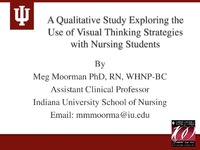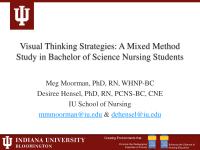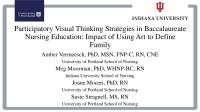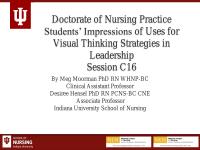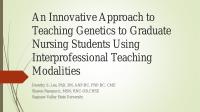| dc.contributor.author | Moorman, Meg | en |
| dc.date.accessioned | 2014-11-17T13:43:38Z | |
| dc.date.available | 2014-11-17T13:43:38Z | |
| dc.date.issued | 2014-11-17 | |
| dc.identifier.uri | http://hdl.handle.net/10755/335077 | en |
| dc.description | <p>International Nursing Research Congress, 2014 Theme: Engaging Colleagues: Improving Global Health Outcomes. Held at the Hong Kong Convention and Exhibition Centre, Wanchai, Hong Kong</p> | en |
| dc.description.abstract | <p>Session presented on Monday, July 28, 2014:</p>
<p><strong>Purpose:</strong> Nurse educators are called upon to provide creative, innovative experiences for students in order to prepare nurses to work in complex healthcare settings. As part of this preparation, teaching observational and communication skills is critical for nurses and can directly affect patient outcomes. Visual thinking strategies (VTS) are a teaching method that has been studied in primary education to develop communication and observational skills. The purpose of this study was to explore the meaning of Visual Thinking Strategies with nursing students. The students also discussed how they used VTS in caring for their patients.</p>
<p><strong>Methods:</strong> Students enrolled in a 6th semester obstetrics course at a large midwestern university were given an option to experience VTS as a homework option. Those students were then recruited during their 7th semester to participate in the research study. Nine students volunteered and informed consent was obtained. These students participated in two 60-minute VTS experiences at a local art museum, facilitated by an art museum educator trained in VTS. Students were then interviewed by the researcher and these interviews were audio taped. These interviews were transcribed and analyzed for common themes. Heideggarian hermeneutics was used as the research method for analysis in this qualitative study. Interviews were conducted based on the following questions: What meaning does VTS have for nursing students? How do students who have experienced VTS use it in their care of patients? Themes were identified during data analysis and verified by a research team experienced in Heideggarian hermeneutics. The researcher also did a literature review following the data analysis to validate and expand findings. Hideggarian hermeneutics was also the philosophical framework for the study.</p>
<p><strong>Results:</strong> Two themes emerged from data analysis of transcripts from participants: Feeling safe in learning and Seeing differently. Also revealed in the findings were themes from the perspective of the researcher; validation, mutual respect, and reformulation of the VTS process into clinical practice. The term "facilitative teaching" was created from this data. Participants in VTS were able to link their interactions with the artwork directly to patient care metaphorically. They also used the process of questioning by the facilitator to question both patients and family members in order to develop a more clear understanding. This ability to translate an educational experience into a real-world experience was identified in the theme of reformation of VTS processes to clinical practice. The VTS facilitator asks participants to take a moment and observe a work of art. After that observation, the facilitator asks the group "What is going on in this painting?" A follow-up question of "What are you seeing that makes you say that?" requires the participant to give visual evidence for what they are seeing and back it up. Educators can pose this question to students in a myriad of ways, without casting judgment or criticism. This question and the attentive listening that occurs afterward are important as one attempts to understand what was said and also requires the student to provide evidential reasoning. At the same time, the facilitator/educator is demonstrating a sincere attempt to understand the response or answer. Students can use this line of questioning in their clinical practice as part of an assessment, or to gain more insight into how patients are thinking. The importance of listening attentively and paraphrasing back cannot be emphasized enough, as these components demonstrate respect from the facilitator/educator. Mutual respect in education can increase the likelihood that students participate and speak up. Finding a voice is an important component of nursing care and communications. The act of looking at a work of art as a whole picture, then breaking it down into smaller pieces and then stepping back and gaining perspective from viewing the whole is a metaphor for how students can view clinical situations. This act of looking enhances students' abilities to assess and observe in clinical situations. Participants in this study were able to translate the experience of VTS into their clinical practice and 'see the big picture'. Nurse educators can incorporate this into their teaching by projecting an image of a complicated work of art onto a screen and asking students "What is going on in this picture?" By following the VTS facilitator questions, students can learn the process of the line of questioning. Then the educator might show a picture of a complicated patient and have students practice breaking the components of the scenario into smaller pieces. This process can model for students how to systematically assess and question, increasing the likeliness that they use this same systematic process in caring for patients. Students can learn to look critically and think systematically. The nurse educator can also model for students how to question and seek understanding without judgment or criticism. The facilitator asked students to take a moment and observe the work of art. The simple act of taking a moment to examine the artwork showed the students that their opinions were going to be considered carefully and that she was going to invite them to participate. She did not call on participants; she simply asked “What is going on in this work of art?” and then allowed students to volunteer. This invitation was important in that it showed a level of mutual respect and recognition that participants were invited to join the discussion, not required to participate. Again, this invitation demonstrates a level of respect for the student, not commonly done by educators. Inviting participation is more respectful than demanding an answer or calling on someone who was not ready to respond. The act of inviting participation is a subtle way for nurse educators to demonstrate respect for students instead of putting them on the spot or making them feel pressured to respond. Mutual respect from nurse educators can be provided by attentive listening, paraphrasing, and seeking further understanding. Nurse educators can provide respect for students by suspending judgment and encouraging expansion of thought. This process can reveal student thinking, at the same time demonstrating mutual respect and collegiality. Again, modeling for students can increase the likelihood that they will use these same techniques in their nursing. In summary, participant interviews revealed aspects of the role of facilitator that nurse educators can incorporate into the classroom. The facilitative teacher can promote mutual respect and validate students, which increases the likelihood that they will participate and find their voice. The facilitative teacher can also expand student thinking by inviting participation and seeking understanding from students about how they understand a concept. As the facilitative teacher listens attentively and paraphrases, she promotes a mutual respect in the classroom. This mutual respect can enhance learning and encourage participation, which helps students to find their voice and be more likely to speak out. As students translate these skills into their clinical practice, they synthesize these concepts into their nursing care. Students who speak out in class and question may be more likely to incorporate that voice into their work as nurses. Nurses who speak out are more likely to communicate with other healthcare workers, which may enhance patient outcomes. Facilitative teaching strategies are realistic and easy to incorporate in any clinical, classroom, or laboratory setting. Information about basic concepts, rationale for use, and ways to incorporate into learning settings are included in the table below.</p>
<p><strong>Conclusion: </strong>Themes of feeling safe in learning and thinking and seeing differently were identified and the term ‘Facilitative teaching’ came from these results. These themes revealed that students were able to explore their thoughts and question because of the way the facilitator questioned them in a safe environment. They were also able to see their work with art and formulate a method to approach their care with patients in hospital settings. Nurse educators can use this teaching method (VTS) inexpensively and promote interdisciplinary educational work with other medical disciplines, as called for by the NIH. Further studies are suggested that would include nursing students working with other disciplines in art museums. Medical, social work, respiratory therapy, and public health students could all be included to develop interdisciplinary educational studies that promote communication and observational skills.`</p> | en |
| dc.format | Text-based Document | en |
| dc.language.iso | en | en |
| dc.subject | Interprofessional Education | en |
| dc.subject | Arts and Nursing Education | en |
| dc.subject | Innovative Teaching | en |
| dc.title | A qualitative study exploring the use of visual thinking strategies with nursing students | en |
| dc.type | Presentation | en |
| dc.rights.holder | <p>
All rights reserved by the author(s) and/or publisher(s) listed in this item record unless relinquished in whole or part by a rights notation or a Creative Commons License present in this item record.
</p><p>
All permission requests should be directed accordingly and not to the Sigma Repository.
</p><p>
All submitting authors or publishers have affirmed that when using material in their work where they do not own copyright, they have obtained permission of the copyright holder prior to submission and the rights holder has been acknowledged as necessary.
</p> | en |
| dc.description.note | <p>Items submitted to a conference/event were evaluated/peer-reviewed at the time of abstract submission to the event. No other peer-review was provided prior to submission to the Henderson Repository.</p> | |
| dc.type.category | Full-text | en |
| dc.evidence.level | N/A | en |
| dc.research.approach | Qualitative Research | en |
| dc.contributor.department | Alpha | en |
| dc.author.details | Meg Moorman, PhD, RN, WHNP-BC | en |
| dc.conference.name | 25th International Nursing Research Congress | en |
| dc.conference.host | Sigma Theta Tau International | en |
| dc.conference.location | Hong Kong | en |
| dc.date.conferenceyear | 2014 | |
| dc.description.reviewtype | Abstract Review Only: Reviewed by Event Host | en |
| dc.description.acquisition | Proxy-submission | en |
